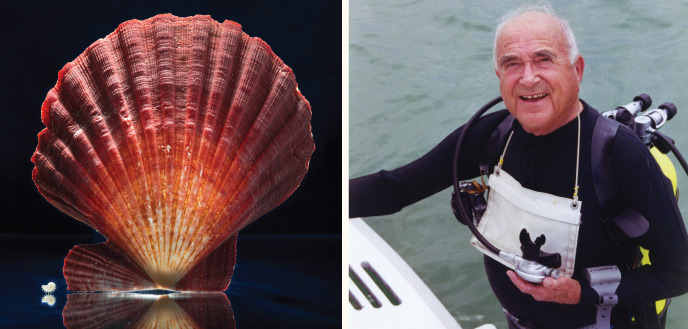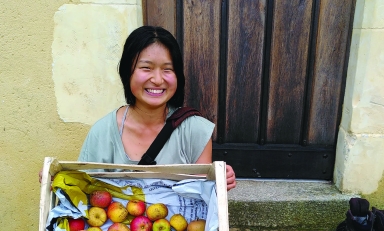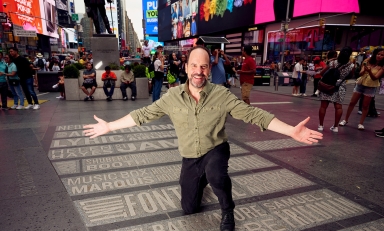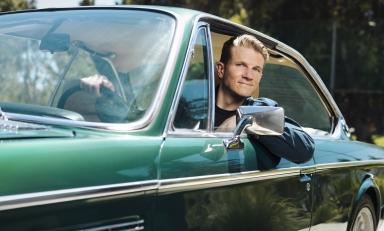
Scouring the oceans, Dieter Cosman cultivated—and meticulously documented—a singular collection of shells from around the world. Now his legacy could trigger waves of discoveries in the marine sciences
Like a ’49er panning for gold, Swiss-born Dieter Cosman spent his life obsessively dredging the sand of the seafloor. But the treasure he sought was not gold or other relics from sunken vessels, but seashells so small he stored them in empty medicine gel caps. Others took both hands to pluck from the bottom of oceans that ranged from the Atlantic to the Pacific to the Indian.
The collection the Florida yacht sales executive amassed over nearly 50 years of diving and dredging was not the showiest, but the most complete. "He just enjoyed the search," says son Ed Cosman ’72. "Collectors have that mentality; they're looking for the missing pieces—the aim is to get everything."
Ironically, while he was justly proud of his international shell collection, "Dad didn't think the collection had scientific value," Ed notes. "He only thought that another shell collector would be interested in it."
Thanks to the generosity of Dieter's widow, Susanne Cosman, and their four children, Occidental associate professor of biology Joseph Schulz and generations of Oxy students will happily spend the future demonstrating that Dieter was mistaken. The roughly 117,000 specimens in the Dieter Cosman Shell Collection recently given to the College "have great scientific value," according to Schulz.
"His collection just screams, 'This is not just about pretty shells. And this is not just about finding what everyone else found,'" Schulz says. "For Dieter Cosman, this was more than a hobby. He had a passion for understanding these animals, for understanding the taxonomy."
Combing the waters for living specimens, Dieter meticulously documented his precious finds with the date, time, location, and depth, providing time capsules for seafloor spaces all over the world that detail information about how shell populations have changed over the decades in response to global warming, pollution, fishing, and other environmental effects. "I don't think he thought for one second that the documentation itself would be equally as important as the shells, but we now know that that is indeed the case," Ed says.
What drew a man who grew up in the mountains of Switzerland to the bottom of the sea? Edgar Cosman owned a textile firm in Basel, Switzerland, as well as Continental Elastic Corp., a factory in New Bedford, Mass., that made parachute cords during World War II. In 1939, when son Dieter was 22, his father sent him to America to work
in New Bedford. That same year, the family bought a failing dairy farm on Long Island, and Dieter was charged with making it profitable. Within a decade, Oak Tree Farm Dairy was solidly in the black, and in 1961 Dieter introduced the "drive-thru" Dairy Barn to the region's residents.
Dieter's life came into focus after his arrival on Long Island. Reflecting a lifelong fascination with the sea, he was only 29 when he bought his first boat, which he named Helvetia (Latin for "Switzerland") and docked at a boatyard in Northport, N.Y. One of his neighbors introduced him to his bride-to-be, a pretty girl named Susanne Elgin whose family had recently relocated from Ohio. Following their marriage in 1948, the Cosmans had four children—and Dieter built his second boat (which he also named Helvetia).
To get away, the Cosmans spent vacations and summers on their boat in Nassau in the Bahamas. In 1966, Dieter and partner Charles Blickle Sr. started Bradford Marine, a yacht business on the New River in Fort Lauderdale. Dieter bought Blickle out and took over the running of the shipyard himself full time in the 1980s.
"He was always a hunter," Ed recalls of his father. "The first thing he started doing was spearfishing. As his interest in slaughtering innocent fish waned, he started picking up shells. He had a very detail-oriented mind and scientifically documented everything perfectly."
The elder Cosman did much of his collecting in the Bahamas on those family vacations. He did other shell-hunting throughout the Caribbean, as well as in Hawaii and the Pacific, and took a few diving trips to the Indian Ocean and the South Pacific. "Choosing places to go was tricky, because it had to have good dive spots for him and a golf course for Mom," Ed says.
For the most part, the Cosman kids were left at home with their German governess when their parents went off on shell-seeking excursions. "She made the Bounty look like the Good Ship Lollipop," Ed says of his caretaker. During vacations, "There were four kids, two adults, and a governess on a 50-foot boat. I don't miss living on a boat."
As Dieter got older, he turned to seeking shells in their juvenile forms. As scuba diving became more difficult, he turned to dredging, focusing on the tiniest shells he could find by bringing up bucketfuls of sand from the ocean floor. Some are no bigger than a grain of sand, but viewed under a microscope, structurally perfect.
"It was the love of his life," says Ed's brother, Doug Cosman. "He'd be happy to talk shells to you all day long if you wanted, but of course nearly nobody did. When he wasn't away on a dive trip, he'd come home from work every day, go down to the basement, and start working on his shells."
By the time he died at the age of 95, Dieter had amassed more seashell specimens than even he could count, stuffed into sealed plastic bags placed in drawer upon drawer in cabinet upon cabinet in his houseboat in Fort Lauderdale. After his death in 2012, the question surfaced: What does one do with such a collection?
Professional shell collectors "began circling like vultures" prior to Dieter's passing, says Ed, the oldest of four and a self-described "carbon copy" of his father (although he "wasn't much of a diver" and didn't share Dieter's interest in shells). But for years, Ed had his own plan for the massive horde—donate the specimens to his alma mater.
"It took a while to find the right person to talk to at the College about whether they would even be interested in the collection," recalls Ed, who majored in business administration at Oxy and ran Oak Tree Farm Dairy for 15 years. "When I finally did, the response was, 'Hell yes.'"
The rest of the family was on board as well. "I was very happy that the collection would go to a world-class institution like Occidental," says brother Doug. "I hope that this provides a way for the collection to be kept together, properly cataloged, and ultimately made available to the world."
Schulz, who specializes in fish-hunting cone snails, traveled to Fort Lauderdale last fall to personally escort Dieter's shells back to the Eagle Rock campus from the houseboat where Susanne Cosman still lives at Bradford Marine. Schulz helped to pack the cabinets onto a moving truck himself. "They were all stuffed in there, and now they're all stuffed in here," he says, gesturing around a closet space in Oxy's Bioscience Building. "The drawers are endlessly piled. We packed them in-drawer, because it would have just been impossible to pull out all of the specimens and pack them individually."
The collection has been valued at about $511,000 and consists of snails (gastropods) and bivalves, two classes of mollusks. Specimens range in size from some of the largest snail species to the microscopic. The collection's largest holdings are from the Indo-Pacific region, with strengths in the Hawaiian Islands, Western Atlantic, Gulf of Mexico, and deep-water species.
The shells come from a fairly broad distribution area, and many of the species among the several thousand in the collection have yet to be identified. Four were discovered by Dieter and named after him. "In terms of novel species and in terms of understanding biodiversity, it's an excellent collection with a lot of material that we can build on for all sorts of research projects," says Schulz, who joined the Oxy faculty in 2004.
"So many of the species are unidentified, new to science. No one has had the time to identify them," says Carlsbad-based shell dealer Rick Negus, who spent a full six weeks on campus appraising the collection. Negus estimates that fully half of the collection consists of microscopic shells. "There were a lot of pretty shells, big display shells, too. A pretty shell can be real small, too. It was kind of all over the place, but it was real impressive—a lot of real obscure families of shells that most people don't collect."
Right now the largest and most fragile shells, such as conches and spiny oysters, are stored on shelves in Schulz's office. The rest are still packed in Cosman's original cabinets—two-thirds in a large closet space in the biology building and another third in Schulz's laboratory. With the financial support of the Cosman family, space in Schulz's office and a neighboring office space will be renovated into a permanent home for the shells, with scientific-style museum cabinets. (Approximately 200 of the flashier specimens are currently on display for public viewing in the Academic Commons.)
A huge task lies ahead for Schulz and his students. It will take at least seven years just to get a basic inventory of the collection done and online, sorting through decades of detailed collecting and specimen data that Cosman carefully noted on Rolodex cards, Schulz says. "We will be fully curating the collection through databasing, geo-referencing, and digitizing. Students will do photography and even 3-D scanning of collection species." As the work progresses, "we look forward to making this collection freely accessible to the scientific community and the world over the Internet."
For starters, "We will be developing an extensive geo-referenced species list of snails and bivalves from the Hawaiian Islands," Schulz explains. "This will allow us to monitor temporal changes in species assemblages and will be used—we hope—as part of snail and bivalve surveying and monitoring in the Northwestern Hawaiian Islands (Papahānaumokuākea) Marine National Monument."
In other words, using the shell collections as virtual time capsules, Schulz and his students will be looking at changes in habitat and shifting population baselines. "People see a habitat today and say, 'That's the habitat.' But that may not be how it looked three decades ago. This collection gives us a snapshot over many decades of what types of species were seen and were directly collected where. So we can go back to those habitats and assess them in terms of 'Do we see the same level of diversity in those habitats, is it changing, is the presence of certain species changing, is the size of the animals changing?'"
Such data can be used to determine which areas should be protected from outside pressures such as fishing practices and development, Schulz says. "It can help us to sort of understand what's changing and the pace of the changes, because we don't fully understand that about the marine environment." Furthermore, by annotating the hundreds of Hawaiian shell species in the collection, "we're hoping that gives us a sense of the type of information to be found in the collection as a whole."
Collin Mostoufi '18 of Claremont has been working on cataloging the Hawaiian species since the collection arrived on campus last fall. This summer, as part of Oxy's summer research program, he is developing the first numeric data, charting the depths at which individual specimens were collected and creating a graphic representation of this information. "The collection is mind-blowing. My spreadsheets are now taking five minutes to open," he says.
There's something else that makes this shell collection of great scientific value—the shells were only minimally cleaned, by hand. "Unlike many collections where the shells are cleaned with things like bleach and whatnot, Dieter Cosman didn't do a lot of that," Schulz says. The shells contain remains of tissue, including a sort of dried skin called the periostracum and the operculum, which is like a snail's trapdoor.
"We have found that we are able to isolate DNA from periostracum and amplify specific DNA sequences," Schulz says. "We have a lot of possibility for genomics." Not only will this help identify and classify species, there is potential for biomedical applications. The Cosman Collection is particularly rich in deepwater turrid snails, the largest mollusk family. "It was Dieter's passion to collect and understand turrids," Schulz says, adding that turrid snails are venomous marine snails similar to the cone snails he studies. There are thousands of different kinds.
The FDA-approved painkiller Prialt was developed from cone snail venom. In a recent Australian study, scientists discovered thousands of toxins in the venom of a single type of sea cone snail in Queensland, which may help develop new drugs to treat pain, as well as cancer and other diseases. "Cone snail venoms are a complex cocktail of many chemicals, and most of these toxins have been overlooked in the past," says Professor Paul Alewood from the University of Queensland Institute for Molecular Bioscience.
"With the help of the Cosman Collection, we will identify the best species prospects to interrogate at the molecular level in the hunt for novel venom peptides," Schulz says. "We'll be identifying novel venom peptide-encoding sequences, having these peptides synthesized and characterizing their activities" in a search for new medications.
Together with the College's 60,000-plus Mexican bird specimens housed in the Moore Lab of Zoology, the Cosman acquisition underscores Occidental's commitment to enhancing its science curriculum. "For a small liberal arts college to have these two world-class collections is very rare," notes President Jonathan Veitch. "It gives us critical mass, and a basis on which to mount an environmental science program together with the immense resources of the ocean, the deserts, and the mountains we have in Southern California."
All of this would doubtless bring a smile to Dieter Cosman, even if he never imagined his collection would have that kind of value. "Dad always told me that his ultimate goal was for the collection to remain intact, to not be subsumed into another collection, and to be useful," Ed says. "It's doing exactly what he always said he wanted."
While Ed has kept a few of his father's shells—a "nice spider conch, some helmet shells, a couple of spondylus [spiny oysters]"—he is glad that the fruits of his dad's lifelong obsession have found a permanent, enthusiastic home at Oxy. "If something wonderful comes of it, great; if it simply provides a research tool for generations of students to come, what more could you possibly ask for?"



